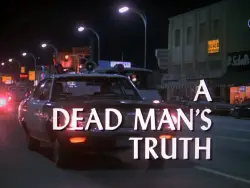A Dead Man's Truth (Quincy, M.E.)
| A Dead Man’s Truth | ||||||||||||||||||||||||||||||||||||||
|---|---|---|---|---|---|---|---|---|---|---|---|---|---|---|---|---|---|---|---|---|---|---|---|---|---|---|---|---|---|---|---|---|---|---|---|---|---|---|

| ||||||||||||||||||||||||||||||||||||||
|
Episode Quote
'"Sometimes the truth isn't what the officer says—it’s what the bullet can't say."
― Dr. Quincy, A Dead Man’s Truth
Episode Overview
A Dead Man’s Truth (Season 3, Episode 3) aired on NBC on September 30, 1977. When a rookie officer shoots a suspected burglar in a darkened store, Quincy receives conflicting reports saying one story isn't completely true, and uncovers a cover-up. :contentReference[oaicite:1]{index=1}
Table of Contents
Application of The QME Episode Laws
✅ **Law 1 – Seek truth and justice:** Quincy challenges the rookie officer’s version of events using forensics—bullet trajectory and powder residue—ultimately revealing the truth behind the shooting. :contentReference[oaicite:2]{index=2}
✅ **Law 2 – Explore social/ethical issues:** The episode tackles police accountability, media sensationalism, and integrity within law enforcement, highlighting Quincy’s role as a bridge between justice and institutional power. :contentReference[oaicite:3]{index=3}
✅ **Law 3 – Handle controversy with sensitivity:** Police shootings and media involvement remain timely and contentious—this episode approaches them with nuance and empathy, avoiding simplistic conclusions.
✅ **Law 4 – Maintain scientific accuracy:** Autopsy demonstrates powder burn pattern, trajectory reconstruction, and hidden bullet discovery—reflecting professional forensic scrutiny. Commentary on bullet impact timing mirrors real investigative methods. :contentReference[oaicite:4]{index=4}
Collectively, these illustrate *Quincy, M.E.*’s commitment to socially relevant, fact-driven storytelling.
Episode Synopsis
Rookie Officer O'Neil shoots an alleged burglar in a dark shop late at night. The cop reports self-defense, but conflicting testimony arises. Quincy’s autopsy reveals close-range powder burns inconsistent with the claimed shot distance, and trajectory evidence including a second bullet lodged behind a shelf suggests a staged scene. With public pressure via TV news coverage, Quincy must determine whether the officer lied. Evidence vindicates the officer in part but reveals hidden facts—balancing truth and nuance.
Plot Summary
A burglary call leads to a shooting. O'Neil states the suspect lunged and he fired in self-defense. Quincy questions this, noting powder burns on the victim and discovering a second bullet. Using bullet hole angles and shelf displacement, Quincy proves the scene was manipulated. A TV reporter sensationalizes the case, but Quincy maintains objectivity. The episode resolves with a balanced finding: the officer shot defensively but the scene was tampered with, highlighting both procedural integrity and real-world complexity.
← *A Blow to the Head… a Blow to the Heart* • **A Dead Man’s Truth** • *A Question of Time* Season 3 Overview: Full Episode List :contentReference[oaicite:5]{index=5}
Main Cast
- **Jack Klugman** as Dr. R. Quincy
- **Robert Ito** as Sam Fujiyama
- **Garry Walberg** as Lt. Monahan
- **John S. Ragin** as Dr. Asten
Guest Cast
- **Dabney Coleman** as Officer Peter O'Neil
- **Mark Lambert** as Officer James Wells
- **Howard Hesseman** as D.A. Jerry Douglas
- **Joseph Gallison** as TV News Director
Case File Summary
Victim: John Doe (burglar) Case #: LACC 77.09.240
Forensic examination reveals second bullet and proximity indicating misreported shooting scenario; evidence of scene alteration is found.
Additional Victims
None.
Alleged Perpetrators
- No foul intent—officer cleared, but evidence shows procedural manipulation.
Filming Locations and Exterior Footage
Nighttime shop exteriors were filmed on-location in downtown Los Angeles for authenticity.
Forensic Science Insight
- **Powder burns** indicate firing distance.
- **Trajectory analysis** identifies bullet path and hidden bullet behind shelf.
- **Scene staging recognized** via displacement of shelf and bullet impact—Quincy's attention to detail models forensic best practices.
Themes & Tropes
- **Police accountability** – examines institutional trust and officer actions.
- **Media influence** – explores sensationalism by TV reporters.
- **Forensics over assumption** – Quincy uses science instead of reputation.
- **Moral nuance in justice** – the episode finds middle ground between faultless heroism and scapegoating.
Reception & Ratings
IMDb rates it 7.3/10 from over 1,000 users. Critics and audience appreciated the episode’s fairness and nuanced portrayal of a complex moral and procedural dilemma. :contentReference[oaicite:6]{index=6}
Trivia
- The bullet shelf concealment mirrored a classic *Dragnet* episode “The Shooting Board.” :contentReference[oaicite:7]{index=7}
Cultural Impact
The episode prefigures modern scrutiny of police shootings and scene integrity, influencing procedural dramas with themes of forensic justice and institutional oversight.
See Also
- Quincy, M.E.
- List of Quincy, M.E. episodes
- Police shootings in television
- Forensic pathology
- 1977 in television
